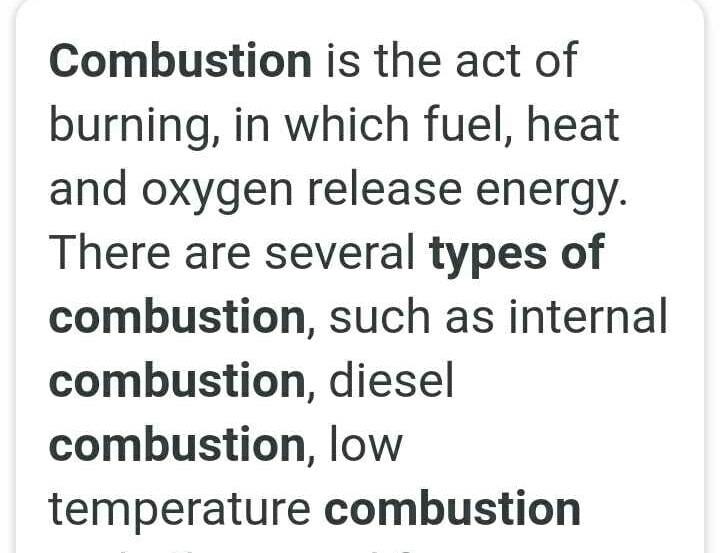Class 8 Exam > Class 8 Questions > Explain the types of combustion with suitable...
Start Learning for Free
Explain the types of combustion with suitable examples?
Most Upvoted Answer
Explain the types of combustion with suitable examples?

Community Answer
Explain the types of combustion with suitable examples?
Types of Combustion
Combustion is a chemical reaction that occurs when a substance (usually a fuel) reacts with oxygen, producing heat and light. There are several types of combustion, each with unique characteristics.
1. Complete Combustion
- Occurs when a fuel burns in sufficient oxygen.
- Produces carbon dioxide (CO2) and water (H2O) as by-products.
- Example: Burning of natural gas (methane, CH4) in a gas stove.
2. Incomplete Combustion
- Happens when there is insufficient oxygen for the fuel to burn completely.
- Results in the production of carbon monoxide (CO), soot, or other hydrocarbons along with water.
- Example: Burning wood in a fireplace where airflow is restricted.
3. Rapid Combustion
- Characterized by a fast reaction with a large amount of heat and light released.
- Often leads to an explosion or fire.
- Example: Lighting a matchstick or fireworks.
4. Slow Combustion
- Occurs at a slower rate, releasing heat gradually without flames.
- Essential for processes like respiration in living organisms.
- Example: Rusting of iron or the decay of organic matter.
5. Spontaneous Combustion
- Takes place without an external ignition source due to self-heating.
- Often occurs in materials that can generate heat from microbial activity or oxidation.
- Example: A pile of oily rags that ignite due to heat build-up.
6. Explosive Combustion
- A type of rapid combustion where gases expand rapidly.
- Produces a shockwave and a loud sound.
- Example: Combustion of gunpowder in fireworks or explosives.
Understanding these types of combustion helps us recognize their applications and impacts on the environment and safety.
Combustion is a chemical reaction that occurs when a substance (usually a fuel) reacts with oxygen, producing heat and light. There are several types of combustion, each with unique characteristics.
1. Complete Combustion
- Occurs when a fuel burns in sufficient oxygen.
- Produces carbon dioxide (CO2) and water (H2O) as by-products.
- Example: Burning of natural gas (methane, CH4) in a gas stove.
2. Incomplete Combustion
- Happens when there is insufficient oxygen for the fuel to burn completely.
- Results in the production of carbon monoxide (CO), soot, or other hydrocarbons along with water.
- Example: Burning wood in a fireplace where airflow is restricted.
3. Rapid Combustion
- Characterized by a fast reaction with a large amount of heat and light released.
- Often leads to an explosion or fire.
- Example: Lighting a matchstick or fireworks.
4. Slow Combustion
- Occurs at a slower rate, releasing heat gradually without flames.
- Essential for processes like respiration in living organisms.
- Example: Rusting of iron or the decay of organic matter.
5. Spontaneous Combustion
- Takes place without an external ignition source due to self-heating.
- Often occurs in materials that can generate heat from microbial activity or oxidation.
- Example: A pile of oily rags that ignite due to heat build-up.
6. Explosive Combustion
- A type of rapid combustion where gases expand rapidly.
- Produces a shockwave and a loud sound.
- Example: Combustion of gunpowder in fireworks or explosives.
Understanding these types of combustion helps us recognize their applications and impacts on the environment and safety.

|
Explore Courses for Class 8 exam
|

|
Similar Class 8 Doubts
Question Description
Explain the types of combustion with suitable examples? for Class 8 2025 is part of Class 8 preparation. The Question and answers have been prepared according to the Class 8 exam syllabus. Information about Explain the types of combustion with suitable examples? covers all topics & solutions for Class 8 2025 Exam. Find important definitions, questions, meanings, examples, exercises and tests below for Explain the types of combustion with suitable examples?.
Explain the types of combustion with suitable examples? for Class 8 2025 is part of Class 8 preparation. The Question and answers have been prepared according to the Class 8 exam syllabus. Information about Explain the types of combustion with suitable examples? covers all topics & solutions for Class 8 2025 Exam. Find important definitions, questions, meanings, examples, exercises and tests below for Explain the types of combustion with suitable examples?.
Solutions for Explain the types of combustion with suitable examples? in English & in Hindi are available as part of our courses for Class 8.
Download more important topics, notes, lectures and mock test series for Class 8 Exam by signing up for free.
Here you can find the meaning of Explain the types of combustion with suitable examples? defined & explained in the simplest way possible. Besides giving the explanation of
Explain the types of combustion with suitable examples?, a detailed solution for Explain the types of combustion with suitable examples? has been provided alongside types of Explain the types of combustion with suitable examples? theory, EduRev gives you an
ample number of questions to practice Explain the types of combustion with suitable examples? tests, examples and also practice Class 8 tests.

|
Explore Courses for Class 8 exam
|

|
Signup to solve all Doubts
Signup to see your scores go up within 7 days! Learn & Practice with 1000+ FREE Notes, Videos & Tests.


























